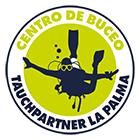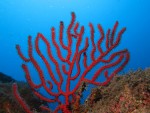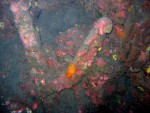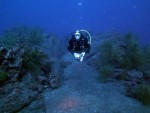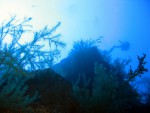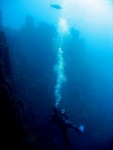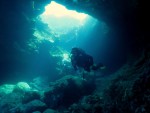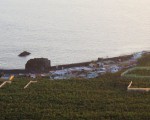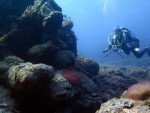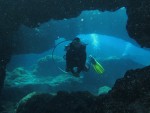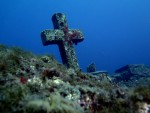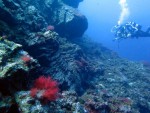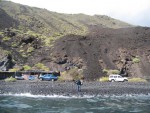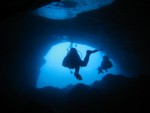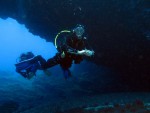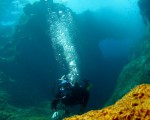Dive Sites around La Palma
La Palma offers a variety of diving sites. The island shows an extremely different structure in both underwater and onshore and with its 3 million years it is geologically very young. La Palma can b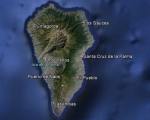 e divided in the older northern part (around the Caldera) and the younger southern part along the Cumbre Vieja.
e divided in the older northern part (around the Caldera) and the younger southern part along the Cumbre Vieja.
The steep coasts of the northern part are a visible sign of its age. Underwater there are mainly flat plateaus made of basalt and sand or boulder and in different places lava caves have been exposed in the steep face The southern part of the island is characterized by a lot of volcanic eruptions – mainly during the last millennium. Here the coast line slopes in steps down to the sea and underwater this structure is continued with many drop offs near the coast. The sea chart shows that the 1000 m depth contour closely reaches the coast. For this reason, La Palma is one of the steepest islands in the world.
The regions  around La Bombilla and Fuencaliente are geologically still very young. In 1949 San Juan’s lava flew into the sea near La Bombilla and only in 1971 Teneguia’s lava at the southern tip of the island. Here you can find many arches and fantastic landscapes made of pillow lava that mainly looks like tubes. Our list of diving sites mainly includes those with special highlights like different lava formations, steep faces, grottos, caves, arches, sand areas or combinations of geological structure and ecosystems and we constantly explore further diving sites.
around La Bombilla and Fuencaliente are geologically still very young. In 1949 San Juan’s lava flew into the sea near La Bombilla and only in 1971 Teneguia’s lava at the southern tip of the island. Here you can find many arches and fantastic landscapes made of pillow lava that mainly looks like tubes. Our list of diving sites mainly includes those with special highlights like different lava formations, steep faces, grottos, caves, arches, sand areas or combinations of geological structure and ecosystems and we constantly explore further diving sites.
Due to the respective sea and weather conditions not all of these sites can always be used without any restrictions. Around nine months (March to December), the weather is determined by the North-East-Trade. This partly strong wind brings clouds and gusts of wind so that e. g. at the eastern side boat dives are only possible to a limited extent. But in this case even shore dives are difficult or impossible except in sheltered bays. Especially in the remaining winter months, western winds or bad weather regions on the Atlantic can lead to big waves at the west coast so that diving there becomes impossible.
Fortunately the small size of the island makes it possible to react to adverse weather conditions within a short time and to always find diving sites at a side of the island that offer good diving conditions. By car we need 40 minutes to get to the other side or to the south. For shore dive we mainly go to diving sites along the west side in the regions of Puerto Naos and La Bombilla, in the south in Fuencaliente and in the east around Los Cancajos. For boat dive with starting point in Tazacorte, the diving site stretches from the north of Tazacorte to the south to the only marine reserve of the island. In case of longer adverse weather situations, the boat can be moved to the east side to Santa Cruz. Nearly all of these diving sites offer optional diving to depths below 40m but all of these sites offer even in shallow depths up to 20m interesting dives and lava formations and so are really suitable for beginners. We are looking forward to showing you this special underwater world of La Palma.
Region Puerto Naos (Diving sides 11-16)
The landscapes of the region Puerto Naos are very different but they all have in common that they steeply slope westwards in different distances to the coast. It varies between sandy areas, lava rocks, steep faces and slopes and canyons. Due to the heterogeneous structure together with the sheltered location and the short distance to the marine reserve the bay of Puerto Naos is one of the most speciose bays of the island.
11 Puerto Naos north “Arena blanca”
Max. depth: >40m Minimum qualification: AOWD Shore dive,
 After getting in at the house reef we remain at the surface for moving northwards. We go down over a sandy field to a depth of approx. 8m. At the edge which is quickly reached there is a slope with big round rocks and smaller sandy areas. At a depth of approx. 35m there is a platform in the slope that is lined with lava rocks. These are beautifully covered with black corals. There are often sting rays on the sandy areas. From there we slowly move southwards up the slope. On our way we are meeting red gorgonians and fairly often bigger groupers.
After getting in at the house reef we remain at the surface for moving northwards. We go down over a sandy field to a depth of approx. 8m. At the edge which is quickly reached there is a slope with big round rocks and smaller sandy areas. At a depth of approx. 35m there is a platform in the slope that is lined with lava rocks. These are beautifully covered with black corals. There are often sting rays on the sandy areas. From there we slowly move southwards up the slope. On our way we are meeting red gorgonians and fairly often bigger groupers.
12 Arecife de la casa
Max. depth: >40m Minimum qualification: OWD
Shore dive Palm trees lined sandy beach, family friendly. Our house reef is in a distance of only 50m. After a slowly descending ground at a depth of approx. 12m there is a reef edge with a slope. The ground there varies between sandy areas, basaltic rocks and lava formations. You can see shoalers (different species of bream, European pilchards, mackerels) and the respective hunters like barracudas, Greater amberjacks and skipjack tunas. Moray rocks with mask-, tiger- or dotted morays. Below 35 m there are black corals and red gorgonians to be admired. Within the sandy areas you can often see different ray species like torpedo rays, sting rays or butterfly rays. In the summer months shoals of barracudas with more than 100 fish can be often seen. Even fans of macrobenthos can discover a lot like different species of anemones, gastropods and shrimps. Not only according to “Unterwasser, 11.2005” one of Canary Islands’ best places for night dives.
13 Puerto Naos Centre
Max. depth: >40m Minimum qualification: AOWD with deep diving experience,Shore dive
Moving westwards over a sandy field the edge which is lined with some lava rocks is reached at a depth of approx. 20m. In the following steep slope there are whole forests of black corals. Between them you can see a historic anchor and a modern anchor with chain from the 50s. A wreck of a smaller ship which usually is completely covered by the sand can be found too. For emerging and getting off we go back to where getting in at the house reef.
14 Puerto Naos south “Cabo del Sol”
Max. depth: >40m Minimum qualification: AOWD, Shore dive
We have a short walk across the beach which is wide at this place before we enjoy the pleasure of diving. After getting in near hotel Sol, a terraced steep face which is beautifully covered with black corals leads into the deep blue. The way back leads up through a volcanic chimney. There is a good chance to see big sting rays and shoals of European pilchards.
15 Punto Dolomiti
Max. depth: >40m Minimum qualification: AOWD, Shore dive
Mit einem kleinen Fußmarsch durch einen kleinen Baranco geht es die Steilküste ca 10m hinab. Der Tauchplatz ist geprägt von einem Lavazug der später in einen terrassenförmigen Abhang übergeht. Die Felsterrassen sind sehr schön mit schwarzen Korallen bewachsen. Ein großes Zackenbarsch ist hier standorttreu und sitzt oft in einer Sandkuhle in ca 35m. Der Blick aus dieser Tiefe zurück zum Ufer offenbart ein Felspanorama wie in den Dolomiten, geprägt von großen zackigen Felsen. Im Flachbereich oberhalb von 10m findet sich ein schöner Canjon und viele Schwarmfische. In den schön mit Braunalgen bewachsenen Felsen lassen sich Oktopanten und Seehasen finden. Da der Strand bei Ebbe nahezu vollständig im Wasser ist kann der Tauchplatz nur bei Ebbe betaucht werden.
16 Punto Dolomiti- Grand Canjon
Max. depth: >40m Minimum qualification: AOWD
Shore dive A short walk through a small ravine leads 10m down the steep coast. The diving site is characterized by a lava flow changing into a terraced slope that is beautifully covered with black corals. A big grouper lives here and often sits in a sandy hollow at a depth of 35m. When looking back from this depth to the shore you have a spectacular view of big jagged rocks like in the Dolomites. In shallow waters above 10m you can see a beautiful canyon and various shoalers and in the rocks which are beautifully covered with brown algae you can find octopuses and Sea hares. At high tide the beach is more or less completely covered with water so the diving site can be used only at low tide.
17 Arco Verde
Max. depth: >40m Minimum qualification: OWD, Boat dive
At the beach of Charco Verde you find Arco Verde an offshore lava flow that has formed a big arch. Directly above the arch we descent to approx.4m. Here the ground is at approx.15m. After passing the archway we go westwards along the lava back through a kind of lava tunnel where many trumpet fish live. At the end of the lava flow at a depth of approx.18m the ground slopes to 40m and a landscape shaped by big lava flows becomes visible. On the way back a further lava tunnel and a big canyon can be admired. For emerging we go back to the lava flow so that emerging offers the possibility to search for octopuses or morays in the beautifully covered lava back.
Region La Bombilla (6,7,8,9,10)
The next bay 5 minutes north of Puerto Naos. The underwater landscape is characterized by San Juan’s lava that emerged here into the sea in 1949. We always get in and start at the landing stage so that in the summer getting in is really comfortable. For your break at the surface there is a kiosk where you can get a really good coffee.
6 Faro de Oeste
Max. depth: 30m Minimum qualification: OWD, Boat dive
Underwater in front of the lighthouse there is a big area with San Juan’s pillow lava that reaches far into the sea. The lava is beautifully covered and you find a lot of clefts and smaller arches where morays live. We are accompanied by shoalers (Mediterranean rainbow wrasse, Chromis chromis, breams and pomacentrids) and with a bit of luck by blowfish, too. Due to its outer position, the site is exposed to current.
7 La Bombilla “Lava cone”
Max. depth: >40m Minimum qualification: OWD Shore dive
Following a sandy street that smoothly slopes from 6m to 10m and shortly through the blue we reach after approx.10 minutes a lava cone that rises up to 20m. It is surrounded by a bizarre lava landscape formed by interlaced lava tubes. The basement of the lava cone is situated at a depth of approx. 50m.
8 La Bombilla “Round tour”
Max depth: 40m Minimum qualification: OWD, Shore dive 5-40m
Changing landscapes from sandy fields over lava lobes to a beautiful canyon, below 35m there is a garden with red gorgonians.
9 La Bombilla “Labyrinth”
Max depth: 12m Minimum qualification: OWD, Shore dive
A landscape with numerous flat arches under solidified basalt.
10 La Bombilla “Outer reef”
Max. depth: >40m Minimum qualification: OWD
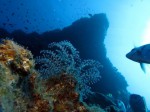 Boat dive 15m to ….! There are merlons up to a height of 15m and a steep face below 30m. On the way a coral garden for advanced divers 😉 Highlight: a more and more spreading field where the rare zoanthid Palythoa caribaeorum lives. Here you find rainbow crabs for sure
Boat dive 15m to ….! There are merlons up to a height of 15m and a steep face below 30m. On the way a coral garden for advanced divers 😉 Highlight: a more and more spreading field where the rare zoanthid Palythoa caribaeorum lives. Here you find rainbow crabs for sure
Region Fuencaliente- South (19,20,21,22)
The south tip is geologically La Palma`s youngest part. Here the island becomes progressively smaller and both east and west sides are only a few hundred meters apart. In 1971 the lava of the Teneguia emerged on both sides into the sea. Underwater and after some small plateaus the ground slopes steeply to vertically.
19 Malpique
Max. depth: >40m Minimum qualification: OWD
Shore dive Probably one of the most impressive diving sites. Basaltic landscape with sandy areas where all possible species of rays can be met. Even angel sharks, mako sharks and mantas we have met there and big blow fish can be mostly found in clefts. –“Pinnacle”: This tour for advanced divers leads you over two basaltic walls through an arch into the blue and finally leads you to the “pinnacle” that rises from 50m up to 30m and is totally covered with black corals. The surrounded sandy field is full of sand eels. –“Cementery”: Probably the island’s most known spot. At a depth of approx. 15m there is a sandy area with a “cemetery” consisting of 40 concrete crucifixes dedicated to the memory of missionaries killed by pirates. –“North Tour”: Following a sandy street we go along a steep face covered with lava rocks to a shallow lagoon (max. 12m). There you can find smaller and bigger clefts as well as a cave. There are some spots where hot water emerges! –“Outer Reef”: Diving into the deep blue of the Atlantic Ocean. At a depth of approx. 30m we reach the outer reef that is formed by beautiful basaltic domes. It slopes down vertically approx. 40m. Here you can often meet a shoal of barracudas.
20 Los Arenales
Max. depth: >40m Minimum qualification: OWD, Shore dive
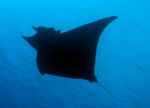 This diving site is situated exactly in the area where Teneguia’s lava emerged into the sea in 1971. After getting in at a small bay we can choose between two tours. When choosing the north tour we go along a slope beautifully covered with tube lava and later changes into a steep face. At the foot of the steep face there is a beautiful and dense forest of corals. We go back along the edge with some canyons, arches and clefts at a depth of approx.10m. A lot of shoalers and the rare fire coral eel can be often discovered here. When choosing the south tour we also go along a slope covered with tube lava. There isn’t much covering but below 30m there are wonderful coral fields. Here as well there are many clefts and holes which morays and groupers like to use.
This diving site is situated exactly in the area where Teneguia’s lava emerged into the sea in 1971. After getting in at a small bay we can choose between two tours. When choosing the north tour we go along a slope beautifully covered with tube lava and later changes into a steep face. At the foot of the steep face there is a beautiful and dense forest of corals. We go back along the edge with some canyons, arches and clefts at a depth of approx.10m. A lot of shoalers and the rare fire coral eel can be often discovered here. When choosing the south tour we also go along a slope covered with tube lava. There isn’t much covering but below 30m there are wonderful coral fields. Here as well there are many clefts and holes which morays and groupers like to use.
21 Las Cabras
Max. depth: >40m Minimum qualification: OWD Shore dive
We get into the water in an idyllic bay. There is a steep face covered with young solidified lava shortly behind the bay’s exit. Blow fish, morays, shoalers, barracudas. Two arches covered with corals make the dive perfect. In addition to Puerto Naos another species-rich diving site. Sometimes you can meet some of the bigger groupers there. Unfortunately they are illegally harpooned so that the population has been reduced recently. Stone, rocky and sandy beach appropriate for not diving partners, too.
22 El Puertito
Max. depth: >40m Minimum qualification: OWD Shore dive
A steep face covered with young lava with partly white sand between and an enormous field where sand eels live. Here you can find some planks and an ancient anchor of a sunken slave-schooner. Pebble beach ideal for having a picnic. Adventurous access across a lava field only by 4×4 vehicles or on foot (approx. 30 min. walk).
Region Los Cancajos
A breakwater sheltered lagoon (max. 7m) with sandy beach which is ideal also for beginners, taster courses and for snorkelling. For your surface break you find some nice bars and restaurants. In our favourite bar “Bar Lambada” you probably get the most beautiful and best baracitos of the island and really good snacks.
30 North tour
Max. depth: 40m Minimum qualification: OWD, Shore dive
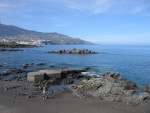 We leave the lagoon at its northern part and dive down to 7m. After some minutes along the underwater part of the breakwater we reach a beautiful canyon. Behind there is a small underwater bay with some overhangs where a blow fish can be found nearly all the time. North-eastwards there is a long lava flow with a lot of jags and clefts. North of the lava flow you can find an enormous sandy field where sand eels live as well as a fragment of a plane wing. At a depth of 28m you can find red gorgonians. During diving groupers and shoals of Salema porgy can be often observed.
We leave the lagoon at its northern part and dive down to 7m. After some minutes along the underwater part of the breakwater we reach a beautiful canyon. Behind there is a small underwater bay with some overhangs where a blow fish can be found nearly all the time. North-eastwards there is a long lava flow with a lot of jags and clefts. North of the lava flow you can find an enormous sandy field where sand eels live as well as a fragment of a plane wing. At a depth of 28m you can find red gorgonians. During diving groupers and shoals of Salema porgy can be often observed.
29 Cavern tour
Max. depth: 15m, Minimum qualification: OWD, Shore dive
At the lagoon’s south exit we swim along the lava coast. After approx.10m there are two eroded rocky islands where rays like to be. On our way back we can dive into two grottos. One of them is only 4m deep and at its entrance 15m wide. On the sandy ground big and pregnant sting rays like to be. The entrance of the second grotto you find at a depth of approx. 7m. In its inner part it rises up to about 4m. At the ceiling there is a big cavity in which.
Further dive sides west side
1 Roque de Aguila
Max. depth: 20m Minimum qualification: OWD Boat dive Several basaltic rocks rise up shortly below the surface and up to 15 m from the ground. Small areas of sand offer a good chance to see rays. There are a lot of groupers.
2 Cueva de Agua dulce
Max. depth: 14m Minimum qualification: OWD, for grotto diving AOWD required Boat dive
Several overhangs and a big grotto have been shaped at the edge of the steep coast. In one of the overhangs you find a freshwater layer over a saltwater layer. There are lots of groupers and European pilchards and a big arch. At calm sea we can dive into the grotto which has two entrances and actually is a tunnel with three rooms. Sting rays like to rest here. Another attraction is big lobsters freely walking around in the grotto. 17 of them have been counted during one dive!
3 Cueva de Diavolo
Max. depth: 35m Minimum qualification: OWD Boat dive
Here you find several eroded grottos. In one of them you can hear the devil hissing when emerging. This is caused by the swell in the air-filled caverns. Outside you find an interesting basaltic landscape with small canyons.
4 Jaulas
Max. depth: 35 m Minimum qualification: AOWD Boat dive
There are big sandy areas and basaltic rocks below the aquaculture. The aquaculture also feeds fish outside the cages so there are hammerhead sharks especially at the surface and on the ground there are big rays. But also hunters like mackerels and tunas can be often met here because fish escape again and again from the aquaculture. Due to the deep diving depth when getting in directly from the boat this diving site is suitable for advanced divers only.
5 Roques de las Hermanas
Max. depth: 35m Minimum qualification: OWD Boat dive
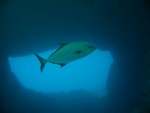 Offshore Playa Nueva three basaltic rocks rise up to the water surface so that they can be seen at low tide. Around these rocks there is a wide sandy area down to a depth of approx. 12m so that these rocks offer a protected habitat for a lot of species. In the most western rock there are two beautiful tunnels. Going westwards at a depth of approx.15m we reach a drop-off to approx. 35m. There we find an impressive landscape characterized by a lot of rocks and canyons. At the edge of the lava rocks at a depth of approx. 30m there is a big sandy field.
Offshore Playa Nueva three basaltic rocks rise up to the water surface so that they can be seen at low tide. Around these rocks there is a wide sandy area down to a depth of approx. 12m so that these rocks offer a protected habitat for a lot of species. In the most western rock there are two beautiful tunnels. Going westwards at a depth of approx.15m we reach a drop-off to approx. 35m. There we find an impressive landscape characterized by a lot of rocks and canyons. At the edge of the lava rocks at a depth of approx. 30m there is a big sandy field.
18 Reserva marina La Palma (marine reserve)
Max. depth: 40m Minimum qualification: OWD Boat dive The only marine reserve of La Palma measuring 3719 hectares was established in 2001. It is situated at the southwest coast of the island and affects about 11 km of the coast line. “The main aim of the marine reserve is the protection respectively the regeneration of fish population relevant for fishing and to ensure “environmentally compatible fishing” so that the local fishermen can continue to follow their traditional trade. At the same time it helps to raise people’s awareness in the ”fishing-environment” area of conflict so that they behave environmentally friendly.” Two zones have been established. Within the Zona Integral (main zone) any activity like fishing, angling and unfortunately diving are forbidden. Within the other zone diving is only admissible with official approval. But this applies to shore angling and professional fishing, too! We regularly apply for the admission which so far can only be done monthly. However you find some interesting diving sites here even though the diversity in species is a bit disappointing. Unfortunately UW-photography is not allowed within the reserve.
Further Dive Sides East side
22 El Arco
Max. depth: >40m Minimum qualification: OWD Boat dive
In its shallow waters there is a big arch that is partly broken so that a beautiful grotto has been formed. Here giant bottle anemones and even lobsters as well as legions of other shrimp species can be found.
23 Rio Muerto
Max. depth: 35m Minimum qualification: OWD Boat dive
A diving site with a beautiful lava landscape and a steep face. In its shallow waters there are arches and beautifully covered lava.
24 Puerta de Diavolo
Max. depth: 35m Minimum qualification: OWD Boat and shore dive
At a lava cape it goes down to approx. 5m. When going eastwards we reach a hole at a depth of approx.18m. Behind this hole you find a giant partly overhanging steep face reaching from approx. 20m to below 60m. On the ground there are sandy fields. The way back leads to shallow waters with beautiful lava formations and arches.
26 La Salimera
Max. depth: >40m Minimum qualification: OWD Shore dive
Salimera is a small settlement at the eastern lighthouse of the island with a beach and a very good kiosk. We get into the water at the beach of Salimera. Here we can choose between two tours. When choosing the north tour we go eastwards along a lava flow and then turn to the north. Here you find big sandy areas between numerous lava rocks that are beautifully covered with black corals below 35m. The way back to the coast leads over sandy areas to the lava covered coast line. With its depths above 10m emerging is great and the numerous clefts can be explored. In its shallow waters you find shoalers and morays and in the deeper area sting rays and torpedo rays. When choosing the south tour we meet an area where big lava tubes have been emerged down the slope. Between them you always find smaller sandy parts.
27 Los Arcos
Max. depth: > 40m Minimum qualification: OWD Boat and shore dive Here lobes have been emerged into the water and continue underwater. In its shallow waters you find many arches and grottos under the lobes.
25 Aeropuerto
Max. depth: >40m Minimum qualification: OWD Shore dive At the edge of a lava rock we start diving at a cape with ground at a depth of approx. 6m. The diving site steeply slopes eastwards. Sandy areas and beautiful lava flows can be admired on the ground. In its shallow waters you can dive through some arches.
